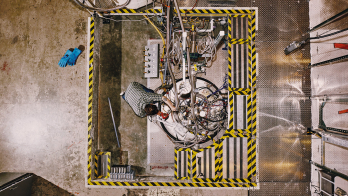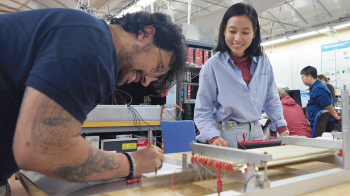The Wide Angle Shower Apparatus (WASA) detector, currently at the CELSIUS facility of The Svedberg Laboratory (TSL) in Uppsala, Sweden, is to find a new home. CELSIUS was commissioned in 1983, using the hardware of CERN’s ICE ring, and its experimental programme will end in summer 2005. The WASA detector, built in the 1990s by a collaboration between Sweden, Poland, Germany, Russia and Japan, will then be relocated to the Cooler Synchrotron (COSY) ring at the Forschungszentrum Jülich (FZJ) in Germany.

WASA is a fixed-target 4π detector comprising a central part and a forward part. The central detector, built around the interaction point, is designed mainly for the detection of the decay products of π0 and η mesons: photons, electrons and charged pions. It consists of an inner drift chamber, a superconducting solenoid and a caesium-iodide calorimeter. The forward detector, designed to detect target recoil and scattered beam particles, consists of 11 planes of plastic scintillator counters and proportional counter drift tubes. The target consists of a beam of frozen hydrogen or deuterium pellets about 25 μm in diameter, which will allow luminosities of up to 1032 cm-1 s-1 in interactions with the circulating beam at COSY.
The transfer of WASA to COSY will be mutually beneficial. Photon detection is important for understanding the physics of hadronic reactions, since many of the produced mesons and excited baryonic states have a significant number of decay branches into multi-photon final states. This calls for a detector with a wide-acceptance electromagnetic calorimeter. Until now, such a detector has been missing from COSY, and WASA fits the bill nicely.
WASA will also benefit from the higher energy of the COSY beam compared with CELSIUS, which is well above the threshold for η’ production in proton-proton interactions. (COSY offers beam momenta of up to 3.7 GeV c-1 with polarized and cooled proton and deuteron beams, whereas CELSIUS can only go up to 2.1 GeV c-1.) WASA will be shipped to the Forschungszentrum Jülich this autumn and the experimental programme is expected to start in the beginning of 2007. Once at COSY, the WASA detector offers an opportunity to deepen our understanding of non-perturbative quantum chromodynamics (QCD) through a precise study of symmetry breaking and very specific investigations of hadron structure.
For example, the η and η’ decays that vanish in the limit of equal-light quark masses (for example η’→ηππ) allow the exploration of explicit isospin symmetry-breaking in QCD. Furthermore, precision measurements of rare η and η’ decays can be used to obtain new limits on the breaking of the charge, parity and time symmetries or their combinations. Last but not least, WASA at COSY can contribute significantly to testing the various models offered to explain exotic and crypto-exotic hadrons – such as the light scalar mesons a0/f0(980), pentaquarks like the Θ+ or hyperon resonances like the Λ(1405) – through precise measurements of decay chains and couplings to other hadrons.
Another promising process where precise measurement can confront theoretical predictions is the isospin-violating process dd→απ0. Pioneering measurements have already been performed at the Indiana Cooler. At COSY such studies can be extended to higher energies and, in particular, to the reaction dd→απ0η, which should be driven by the isospin-violating a0-f0 mixing.
COSY can produce more than 106 η’ mesons per day, and their subsequent hadronic, radiative, leptonic and forbidden decays can be detected by WASA. The expected event rates will substantially increase world statistics.
• The WASA-at-COSY project is a collaborative effort between many institutions, in particular TSL and FZJ. The project currently comprises 137 members from 24 institutes in seven countries.








